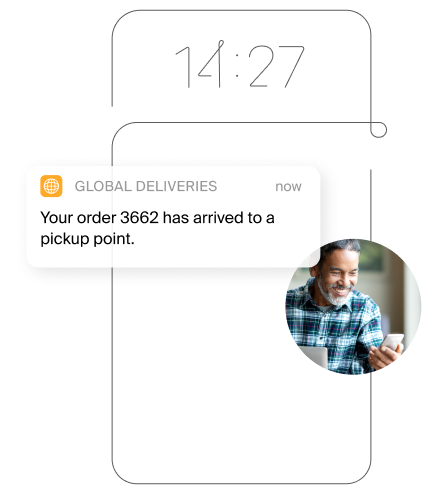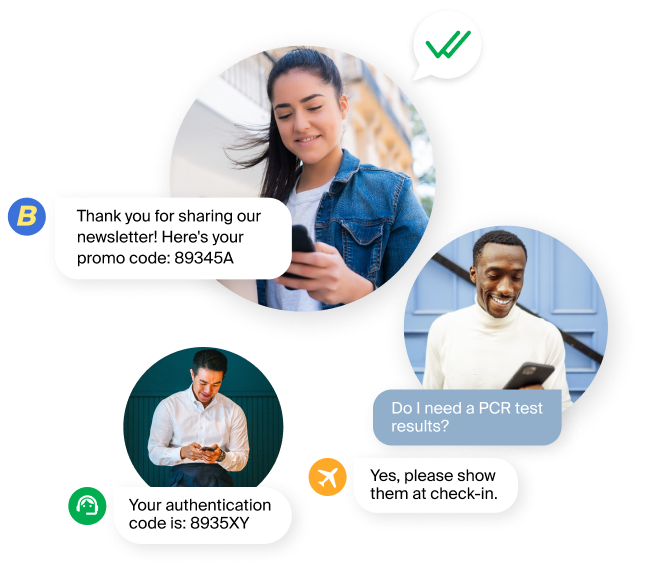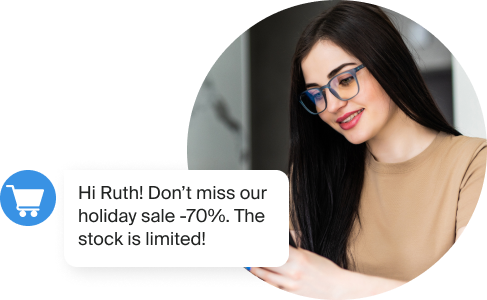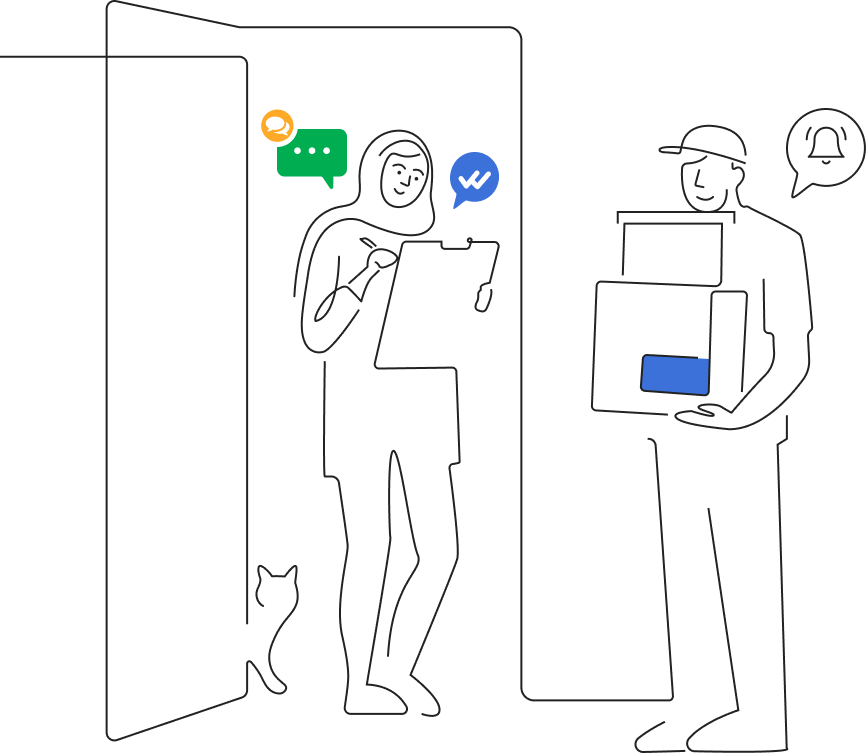SMS and push notifications are an essential component of omni-channel customer journeys. According to the latest reports, 75% of consumers are OK with receiving SMS from brands while the average app push notification opt-in rates are 73%. With high opt-in rates, immediate visibility, and a lucrative conversion potential, these two channels represent a powerful way for brands to reach their consumers with relevant content. In fact, a 2023 survey report by Validity reveals that text messages from brands (SMS and WhatsApp) have influenced 38% of customers to buy a service and 50% to buy a product. However, it’s not just ecommerce and retail brands that can benefit. Consumers are increasingly interested in receiving appointment, delivery and financial reminders via text, so SMS and Push can also be successfully used in finance, healthcare, mobility, tourism and other industries.
Whilst this type of short marketing and sales message seem simple on the face of it, there are a host of best practices that can make the difference between a purchase and an instant opt out. Below we’ve highlighted 9 of our hottest tips for crafting a great SMS or push notification, so check them out before you write yours!

1. Identify the Use Case
As a rule of thumb, push notifications and, to a certain extent SMS, are best used for transactional messages that benefit your customers. Indeed 93% of customers want to receive delivery alerts, and 98% feel these essential messages build trust and promote brand loyalty. Brand awareness and highly promotional messages can be created to greater effect with the multimedia messaging capabilities of WhatsApp and Viber. That said, SMS is also a great failover for these two channels in case of initial message non-delivery. Push and SMS are also best suited for slightly different use cases, although there is some overlap.
When SMS is Best
- Time sensitive information like transactional messages about shipping, order and delivery and reservation and appointment reminders
- Important information such as order cancellations
- Information that needs to be stored for later use like Buy Online Pick Up In-store codes and loyalty vouchers
- Two-way communications like feedback and surveys
- Secure information like two-factor authentication codes
When Push Prevails
- Real-time order updates e.g. for fast-food delivery apps
- Reminders/offers that reduce cart abandonment
- Interesting brand news or upcoming in-store or online events
- Promoting relevant website content
- Communicating account-holder information like outages, or app maintenance
- Limited time offers like flash sales and discounts with a deadline
2. Personalise & Segment
As revealed by 3radical’s 2022 consumer survey report, 54% of respondents are willing to share their personal data with brands in exchange for tailored offers and promotions. SMS and Push notifications are convenient channels to promote such offers as they are likely to be instantly read. One thing to have in mind here is that you should make sure the offers are truly relevant to your consumers. 52% of consumers feel frustrated when they receive offers that are not relevant to them, so this can harm your brand image long term.
To achieve the expected level of personalisation, you need to carefully segment the audience and tailor the content. Using their first name in your messaging is a good start but you need to go beyond this and make your customer feel fully understood. One important aspect to consider is the difference in the buying behaviour of different generations, which should help you address your target audiences’ personal preferences. Location-specific gifts such as local store vouchers and coupon codes, as well as loyalty schemes that send customers birthday offers help create a stronger relationship. Both SMS and push notifications can be sent automatically, triggered by a pre-specified action on your website. They can also pull in related info like recently viewed items to provide customers with additional personalised options. By sending a highly personalised real-time message, you can create huge value and gain emotional buy-in without complex marketing effort.

3. Make Your Headline Meaningful
The first thing your customer should see is your logo and brand name, so they know instantly the message is from your business. The next element in a push notification is the headline. The goal is for your customers to immediately recognise that the topic is important and read the whole text, so here the context is key. A shorter heading such as “New Statement” for a bank alert or “Refund Issued” for an eCommerce store, can help the recipient understand what it is about.
The headline for all types of messages should be on-brand, relevant, snappy, carefully proof-read, informative and compelling. For a push notification your subject line should be up to 50 characters. It’s essential to imbue maximum value into as few words as possible.
4. Create Spam-Free Copy
The body of your message should match the tone of your brand persona. If you run a young person’s clothing brand and your marketing communications are usually friendly, fun, upbeat and casual, then stick to this conversational vibe in your messages. If you’re sending a push notification from a medical app, you’ll want to adopt a more professional tone of voice. Given the brevity of push, it’s more difficult to get your brand personality across but, with SMS, you can use emojis and GIFs to add personality and express emotions. Don’t be tempted to use all capital letters, or lots of exclamation and question marks as they’re intrusive and give the impression of shouting.
5. Be Informative but Concise
Brevity is paramount with push notifications as they tend to be more urgent, and the average length is around 14 to 25 words. As SMS have more longevity and remain in the customers’ inbox, customers are generally happy for them to contain additional information they can refer back to at a later date. You can add images of products to remind them what goods they’ve purchased and help identify the order or upsell and cross-sell to them. That said, concision is still important if you want your customer to stay opted-in to your messaging long-term. Being concise shouldn’t come at the expense of essential information, as both are vital to a great CX. For delivery status messages include identifiers like your brand name, the customer’s account number and their order number or appointment date, so they instantly know which one the message is about.

6. Craft a Clever Call to Action
Both SMS and push notifications need a call to action if sent for promotional purposes. This should take the form of a few words and a clickable link, for example, “schedule your appointment now [link to your calendar scheduling software]”. Create a compelling reason and a sense of urgency, for example “Order today to get free 1 day shipping [link to eCommerce site]”. Using numbers or characters to show an offer amount or personalising the offer in your customers preferred or local currency will also increase conversions. CTAs like these can improve push notification campaign outcomes by more than 40%, so it’s worth taking the time to write them well.
7. Enable an Easy Opt-Out
Enabling recipients to opt-out and update notification frequency is essential to a good CX. If you don’t provide them with an unsubscribe option they could get overwhelmed by your messaging, opt-out from all your communications, and stop purchasing from you altogether. Giving them the choice mitigates this risk.
8. Be Timely
The average American smartphone user receives 46 push notifications a day and 42% will change their notification settings if they receive too many from one brand. The right message frequency will depend upon the context of your messages and whether you’re using push or SMS. If you’re sending out a two-way communication SMS feedback sequence with three questions, then set your automation so the survey questions arrive in quick succession as soon as you receive the first answer. Similarly, if you’re sending fast food delivery updates by push notification, like Deliveroo, or eCommerce delivery updates by SMS, like Amazon, they need to be sent in real-time as the delivery status changes.
Send the minimum number of messages required to get the most important information across to your customers. E.g. if you own a grocery delivery store, your SMS delivery notification sequence might consist of three messages:
- An “out for delivery” message with a link to the delivery timeline and a live map;
- A “delivery arriving soon” update when the order is 30 minutes away; and
- A “delivered” message so that the customer knows to contact you immediately if they haven’t received it, so they can ensure it hasn’t been delivered to the wrong address.
Research shows that, for push notifications that don’t need to go out in real time, the highest conversion rates are achieved at 12:00-2:00pm and 9:00-11:00pm, and Tuesdays and Sundays are the highest conversion days.

9. Measure and Improve Your Messages
Continuous improvement is the key to keeping customers engaged, so make sure you split test and craft new messages in direct response to your message data analysis. You should A/B test different aspects of your SMS and push notifications, specifically trialling different headlines, timings, frequency and calls to action. Set key push and SMS metrics like delivery and open rates, message engagement, CTA conversion rates, and the number of opt-ins and opt-outs, and analyse them according to your customer segmentation. This enables greater personalisation, which improves the CX and engages customers sufficiently to motivate through your funnel.
Conclusions
The starting point to improving your CX with SMS and push messages is to make them on-brand, relevant, personalised and timely, and carry this thinking through from the subject line to the CTA. With 58% of customers willing to pay more for a favourable customer experience, SMS and push are a fast and effective way to modernise your marketing strategy and boost your revenue.

